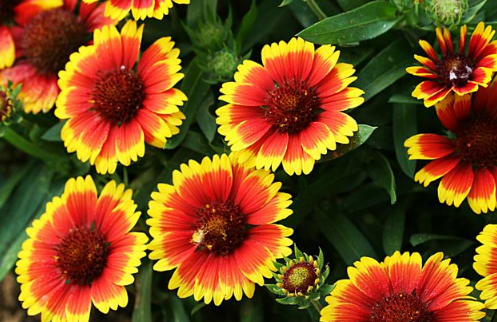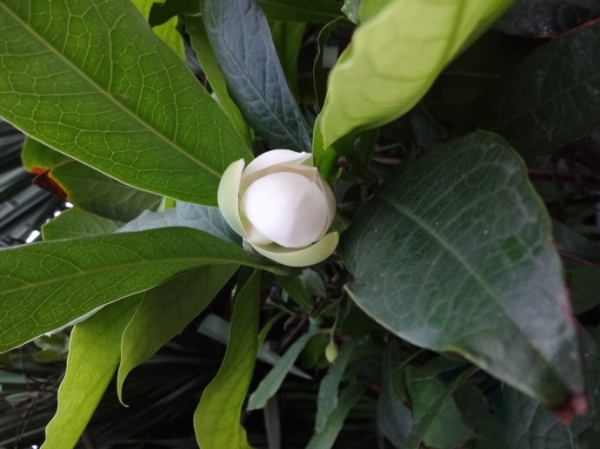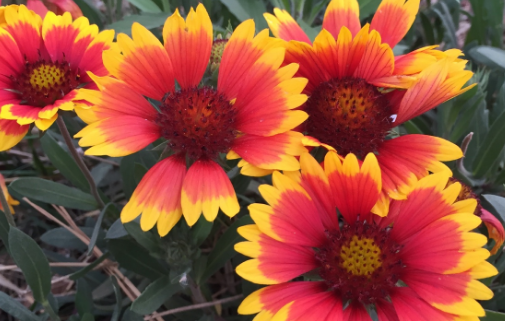Propagation methods of Chrysanthemum morifolium
cutting propagation
Cuttage propagation is also a relatively simple method of propagation. Cuttings to choose the material called cuttings, cuttings usually choose good growth, no pests and diseases of the top. The temperature of cuttings should be kept between 18℃ and 25 ℃. Cuttings should pay attention to disinfection, if the temperature is too high, it is easy to cause infection. At the same time, in case of low temperature climate, it can be covered with thin film to increase the ambient temperature. Shade is also necessary to block more than half of the sun.

seed reproduction
Sowing and reproduction are often chosen in summer. Seed and substrate are treated before sowing. The substrate should be disinfected to achieve the effect of killing pests. The seeds should be soaked in warm water for 3-10 hours, depending on the situation, as long as the seeds swell up. Some seeds are small and difficult to sow by hand. They can be placed on the surface of the substrate with tweezers. After all seeds are sown, a layer of substrate should be attached, about one centimeter thick.
After sowing, you can choose to lightly wet the substrate with spray to avoid washing out the seeds due to excessive watering. Finally, cover the film again. After sowing, the seedlings should be removed from the film when they emerge, and the seedlings should be exposed to light regularly. Attention should be paid to avoiding strong light irradiation, for example, they can be exposed to light before nine o'clock.
Everyone is interested in chrysanthemum, but must not miss its flowering ah!
The breeding method of chrysanthemum
The breeding method of chrysanthemum
There are generally three methods of propagation of chrysanthemum, namely sowing and cuttage. Generally more commonly used is also the most familiar is the sowing method. Let's study separately.
seed reproduction
Sowing and reproduction are often chosen in summer. Seed and substrate are treated before sowing. The substrate should be disinfected to achieve the effect of killing pests. The seeds should be soaked in warm water for 3 to 10 hours, depending on the situation, as long as the seeds swell up. Some seeds are relatively small and difficult to sow by hand. They can be placed on the surface of the substrate with tweezers. After all seeds are sown, a layer of substrate should be attached, about one centimeter thick.
After sowing, you can choose to lightly wet the substrate with spray to avoid washing out the seeds due to excessive watering. Finally, cover the film again. After sowing, the seedlings should be removed from the film when they emerge, and the seedlings should be exposed to light regularly. Attention should be paid to avoiding strong light irradiation, for example, they can be exposed to light before nine o'clock.
cutting propagation
Cuttage propagation is also a relatively simple method of propagation. Cuttings to choose the material called cuttings, cuttings usually choose good growth, no pests and diseases of the top. The temperature of cuttings should be kept between 18℃ and 25℃. Cuttings should pay attention to disinfection, if the temperature is too high, it is easy to cause infection. At the same time, in case of low temperature climate, it can be covered with thin film to increase the ambient temperature. Shade is also necessary to block more than half of the sun.
Notes on the reproduction of celestial chrysanthemum
After sowing and breeding, pay attention to removing the film and giving appropriate light after the seedlings emerge. The light time should avoid the strong light period at noon, usually before 9 a.m. to 3 p.m., and the middle time should be placed in the shade. After the seedlings grow out one after another, proper thinning should be done, that is, pulling out the seedlings with poor growth and leaving room for growth and sufficient water and nutrients for the seedlings with good growth.
Cutting is to control the temperature, the temperature is too low is not conducive to the growth and survival of cuttings after cutting, temperature is too high will lead to cuttings infected with bacteria. Cuttings should also be done after the appropriate shade, about the shade effect should be more than half, the temperature is high to increase the number of water spraying.
Natural chrysanthemum, natural chrysanthemum cultivation methods, natural chrysanthemum conservation knowledge
Today's flower bonsai network to share with you is about the chrysanthemum, chrysanthemum cultivation methods, chrysanthemum conservation knowledge of the article, let's take a look.
Introduction to the heavenly chrysanthemum
Gaillardia pulchella (scientific name: Gaillardia pulchella), also known as tigeria, tiger skin chrysanthemum (Shanghai), central chrysanthemum, vector car Gaillardia, is a Compositae plant of the genus Gaillardia, distributed in North America, tropical America, continental America, native to the central United States, is a very short growth period of annual plants, has been artificially introduced cultivation.
Chrysanthemum is the state flower of Oklahoma and the county flower of Penghu County in Taiwan Province of the Republic of China. Chrysanthemum drought-resistant hot, not cold, like sunlight, but also resistant to semi-shade, good drainage should be loose soil. Chrysanthemum is wind-resistant, moisture-resistant, hardy and drought-resistant. It is a good wind-proof and sand-fixing plant. Chrysanthemum is the state flower of Oklahoma and the county flower of Penghu County, Taiwan.
Morphological Characteristics of Dendranthema chinensis
Anthema is an annual herb. The plant is about 20 - 60cm tall, and the whole plant is pilose. Leaves alternate, lanceolate, oblong to spatulate, entire or basal leaves pinnatifid. Petaloid, ligulate flower apex yellow, base brownish purple. Flowering summer, autumn. The flowers are funnel-shaped, with large flowers and safflower varieties. The flowering period is 7-10 months and the fruiting period is 8-10 months. The flower of the chrysanthemum belongs to the "head", and the "flower" is actually a bunch of flowers, because it contains many flowers and tubes. The outer flowers are colorful, like tarmac to attract insects; the middle flowers grow like small balls. When the flowers wither, this part will develop fruit clusters, and the seeds inside will be scattered by the wind and grow on the ground. In addition, some of the flowers grow into tubes, which look like curved trumpets; some varieties are bright yellow in color, with unique charm; and the leaves and hairs of the chrysanthemum are also worth observing.
Ecological Habits of Anthema chinensis
Anthema likes high temperature, dry and sunny environment. It has good salt tolerance, strong wind resistance, drought tolerance, cold tolerance and shade tolerance. Chrysanthemum native to North America, drought and heat resistance, not cold, like sunlight, but also resistant to semi-shade, suitable for good drainage loose soil. It is wind-resistant, moisture-resistant, tough, drought-resistant characteristics is a good wind-fixed sand plants. If in acid soil, not only difficult to get seedlings, summer leaves wither, rapid growth fertilizer should be applied early, phosphorus and potassium ratio needs to be higher.
Cultivation techniques of chrysanthemum
Chrysanthemum cold resistance is good, no special requirements for soil, but sandy soil and good drainage soil is most suitable for its growth, and do not like wet. It is drought tolerant and grows well in sunny, dry and hot climates, and is common in felt fields and along miles of roads from summer to late autumn. In horticulture, further flowering can be promoted by removing flower buds. In winter, the aboveground part withers, the roots stay underground for winter, and germinate again in spring.
Chrysanthemum can be propagated by sowing, dividing and cutting, while root cutting requires certain technology.
A lot of cultivars have been selected, mainly cultivars with alternating red and yellow whorled disks. A recently selected cultivar, Sundance Bicolor, has a head of alternating red and yellow flowers because it is bright and suitable for growing in sunlight. The flower type of this cultivar is very similar to that of chrysanthemum. Plume is a species of chrysanthemum with double petals, similar to cornflower.
Sowing propagation is often carried out in the summer. The best way to disinfect the substrate used for sowing is to put it in a pan and fry it. Any pests can be scalded to death. Soak the seeds in lukewarm water (about the same temperature as washing your face) for 3 to 10 hours until they absorb water and swell. For common seeds that germinate easily, this work can be omitted. For small seeds that are difficult to pick up by hand or other tools, wet one end of the toothpick with water, stick the seeds one by one on the surface of the substrate, cover the substrate 1 cm thick, and then put the planted flowerpot into water, the depth of water is 1/2~2/3 of the height of the flowerpot, and let the water slowly soak up. For larger seeds that can be picked up by hand or other tools, place the seeds directly into the substrate and sow them at intervals of 3×3 cm. After sowing, cover the substrate, and the covering thickness is 2~3 times of the seed grain. After sowing, spray and fine hole shower can be used to wet the seeding substrate, and then sprinkle when the pot soil is slightly dry, still pay attention to the watering intensity not too much, so as not to flush the seeds; Management after sowing: After the seedlings are unearthed, the film should be removed in time, and before 9:30 every morning, or after 3:30 in the afternoon, the seedlings will be exposed to the sun, otherwise the seedlings will grow very weak; Most of the seeds need to be properly thinned: Remove the diseased, unhealthy seedlings, so that there is a certain space between the remaining seedlings; when most of the seedlings grow 3 or more leaves, they can be transplanted into the pot.
Cuttage propagation used for cuttage branches called cuttings. Usually combined with the work of picking, the thick, disease-free top shoots taken off are used as cuttings, and the top shoots are directly used for cutting. After cutting, attention should be paid to the following management: temperature: the optimum temperature for cutting rooting is 18℃~25℃, below 18℃, cutting rooting is difficult and slow; above 25℃, cutting cuttings are easily infected by bacteria and rot, and the higher the temperature, the greater the proportion of rot. After cutting encounter low temperature, insulation measures are mainly used to cut the pot or container wrapped with film; cutting temperature is too high temperature, cooling measures are mainly to cut shade, to cover 50~80% of the sun, at the same time, to cut spray, 3~5 times a day, sunny temperature higher spray times are more, rainy days lower temperature is larger, spray times are less or not spray. When transplanting seedlings into pots, first put 2~3 cm thick coarse grain matrix or ceramsite as filter layer at the bottom of the pot, sprinkle a layer of fully decomposed organic fertilizer as base fertilizer, the thickness is about 1~2 cm, and then cover a layer of matrix, the thickness is about 1 ~2 cm, and then put in plants to separate the fertilizer from the roots to avoid burning roots. The substrate used in the upper basin can be selected from one of the following. Vegetable garden soil: slag =3:1; or garden soil: medium coarse river sand: sawdust (residue)=4:1:2; or paddy soil, pond mud, rotting leaf soil. or peat + pearlite + ceramsite =2 + 2 + 1; vegetable soil + slag =3 + 1; peat + slag + ceramsite =2 + 2 + 1; sawdust + vermiculite + medium coarse river sand =2 + 2 + 1. After finishing the basin, pour a permeable water, and put it in a slightly shady environment for a week. When transplanting seedlings, dig planting holes first, sprinkle a layer of organic fertilizer at the bottom of planting holes as base fertilizer (base fertilizer), the thickness is about 4~6 cm, then cover a layer of soil and put seedlings in order to separate fertilizer from roots and avoid burning roots. After putting in seedlings, backfill soil, cover roots, step on soil with feet, and irrigate once. Two times before flowering, usually to promote the germination of more flowering branches; one to two weeks after the pot, or when the seedling height of 6 - 10 cm and more than six leaves, remove the top, retain the lower 3 - 4 leaves, promote branching. After 3~5 weeks of the first topping, or when the lateral branches grow to 6~8 cm long, the second topping is carried out, that is, the top tips of the lateral branches are removed, and the 4 leaves below the lateral branches are retained. After two times of topping, the plant type will be more ideal and the number of flowers will be more.
Management and Conservation of Chrysanthemum
Humidity management likes higher air humidity, air humidity is too low, will accelerate the withering of single flowers. Also afraid of rain, need to keep leaves dry at night. The optimum air relative humidity is 65~75%. Temperature management is resistant to heat and frost. Light management likes sunshine, slightly tolerant of half shade. Fertilizer and water management Tianrenju, like other grass flowers, has more requirements for fertilizer and water, but it is required to follow the principle of fertilization (water) of "light fertilizer, frequent application, small amount and complete nutrition", and after fertilization, the leaves and flowers should be kept dry at night: summer and autumn: it is the peak season for growth, and the fertilizer and water management should be in accordance with the order of "flower treasure"-"flower treasure"-"clear water"-"flower treasure"-"flower treasure"-"clear water"(at least twice a week). Appropriate fertilizer control after flowering period to facilitate seed maturity.
The distribution area of the chrysanthemum
Chrysanthemum native to the central United States, is a very short growth period of annual plants, has been introduced by artificial cultivation.
The plant is distributed throughout North America, tropical America, and continental America.
Garden Use of Anthema
Tianrenju is a very good sand greening, beautification, fixed sand herbs. Its flower posture is delicate, the color is gorgeous, the flowering period is long, the cultivation management is simple, may make the flower bed, the flower cluster material. Nurturing management: cultivation soil to loam or sandy loam best. Drainage, sunshine should be good, if insufficient sunshine, will affect poor flowering, fertilization once a month. The optimum temperature for growth is 10 - 25 ℃.
Cultural background of chrysanthemum
Flowers of Penghu County
Chrysanthemum is the county flower of Penghu County, China Taiwan Province. It can be seen everywhere in Penghu, so Penghu is called chrysanthemum island.
The whole plant has fur, which can prevent water loss, which is the main reason why the chrysanthemum can survive in harsh environments. The leaves are slender, the flowers are yellow and red, a few are golden yellow, the flower stems are long and upright; the seeds are scattered with the wind and grow on the ground. Wind resistance, drought resistance, moisture resistance, natural toughness, is a good windbreak fixed sand plants.
Because of its high fecundity and vitality, after it was first introduced from North America, it flourished at an alarming rate on the Penghu Islands and the central and northern coasts of Taiwan. Today, the beautiful chrysanthemum has become one of Penghu's tourist attractions, and because of its strong characteristics, it has been selected as Penghu's county flower.
Poetry quatrain [Tianrenju] Author: Fisherman strong wind rope to discuss the top flower feather, achene flying everywhere stop. Field expansion rewards barbarism, flowering if to and fragrant.
The flower language of Tianrenju
The flower language and symbolic meaning of chrysanthemum: unity and unity.
- Prev

Matters needing attention in breeding night flowers
The night flower should not be watered too frequently to prevent the root rot caused by stagnant water at the bottom. Can often spray water to the leaves, in the form of fog without water flow, to prevent root rot. And it likes to grow in a warm, humid and sunny environment, but it also needs proper shade on hot summer days.
- Next

Matters needing attention in the Culture of Chrysanthemum morifolium
When the seedlings of Chrysanthemum morifolium are to be transplanted into the pot, we should pay attention to putting some broken tiles and bricks at the bottom of the flowerpot to make a filter layer, sprinkle some rotten fertilizer as the base fertilizer, and put another layer of soil on the base fertilizer. After that, you can plant the plant and water it once after planting.
Related
- Fuxing push coffee new agricultural production and marketing class: lack of small-scale processing plants
- Jujube rice field leisure farm deep ploughing Yilan for five years to create a space for organic food and play
- Nongyu Farm-A trial of organic papaya for brave women with advanced technology
- Four points for attention in the prevention and control of diseases and insect pests of edible fungi
- How to add nutrient solution to Edible Fungi
- Is there any good way to control edible fungus mites?
- Open Inoculation Technology of Edible Fungi
- Is there any clever way to use fertilizer for edible fungus in winter?
- What agents are used to kill the pathogens of edible fungi in the mushroom shed?
- Rapid drying of Edible Fungi

